FOR ADVERTISING
CONTACT:
Prem Dutt: Email
Call Prem: (916) 743-8316
Seema Gupta: Email
Call Prem: (408) 745-9663
|
|
EDITORIAL:
Dalits Rising
 After centuries of oppression, Dalits in Uttar Pradesh are beginning to flex their political muscle. For the first time, India’s largest state, which has given the nation most of its prime ministers, has a Dalit chief minister whose party has an absolute majority in the state legislature. After centuries of oppression, Dalits in Uttar Pradesh are beginning to flex their political muscle. For the first time, India’s largest state, which has given the nation most of its prime ministers, has a Dalit chief minister whose party has an absolute majority in the state legislature.
In Uttar Pradesh’s Byzantine caste calculus, elections are a complicated numbers game. Mayawati, its new Dalit chief minister, has shown remarkable political savvy in courting the state’s Brahmins.
This is not the first time Mayawati has been chief minister of U.P. However, her previous shaky partnership with the Bharatiya Janata Party was a disappointment, not least to her own Dalit constituency because her administration was characterized more by personal quirks and ostentatious symbolism rather than any substantive improvement of the lot of the Dalits.
India, Pakistan at 60
As Indians and Pakistanis celebrate 60 years of independence in August, we present a special section to commemorate this happy occasion.
The two neighbors have fought several wars, and if truth be told, some of that bitterness has spilled over into the expatriate communities as well.
Happily, it is also true that more often than not both Indians and Pakistanis in the U.S. have rediscovered anew the enormous cultural and social ties that they share. This has often led to a warmth and camaraderie that has been in contrast with the petty bickering that has often characterized bilateral relations between the two nuclear-armed neighbors.
Whether it is a Bollywood film or a Ghulam Ali concert, Indian Americans and Pakistani Americans flock to enjoy it together here, a privilege that is denied to them at home.
The Indus Entrepreneurs, the prestigious flagship founded by high-tech South Asian entrepreneurs, now has chapters in Pakistan as well as in India. In the Silicon Valley itself Pakistani and Indian high tech entrepreneurs work together closely in TiE.
This is a wonderful example of fraternal kinship in a world all too often beleaguered by tension and conflict, and we at Siliconeer decided to celebrate it with a special section honoring both the South Asian neighbors on their Independence Day.
Veteran Birla executive Bharat Parekh and our own correspondent Ras Hafiz Siddiqui present two heartwarming, memorable articles for our special section.
|
This time around, though, the Dalit leader seems to have matured, and this administration could well be a different story. In this month’s cover story, our India editorial consultant Sandeep Pandey, himself a U.P. resident, reflects on what her victory could mean for the Dalits.
"Gandhigiri" is a new term coined by the runaway hit franchise of Munnabhai films. The concept, named after Mahatma Gandhi, has a quirky charm that would surely make the Mahatma smile. In a world of crooks and malingerers, Gandhigiri is a way where you use nonviolent techniques to take on malign forces to shame them into coming to the path of justice.
It’s all a fair bit of fun, but does this actually work in the real world as well as it does in Bollywood?
Well, irate desi Green Card applicants decided to give it a shot. When they heard the U.S. Customs and Immigrations Service had suddenly decided to stop accepting applications, they flooded the USCIS director’s office with flowers.
And guess what? Within a few days the USCIS reversed its decision. Of course, lawmakers pitched in to help as well, but we also think these protesters deserve credit for expressing their frustration with style, charm, and a gentleness that the Mahatma would approve.
Barring a minor if impassioned bark of protest from conservative Christians, a historic moment in the U.S. Senate passed without much untoward incident. Reno, Nevada-based Hindu priest Rajan Zed presented a Hindu prayer there, the first time something like this has happened in the U.S. Senate.
Hindus all over the world rejoiced, of course, but there is reason for all Americans to be pleased. As the United States gets more diverse, with people from all parts of the world bringing diverse cultural and religious values, the U.S. Senate’s gesture sends a welcome message of a warmhearted tolerance and acceptance that not only augurs well for the nation’s future but also does the Senate proud.
Do drop us a line with ideas and comments about how we can make Siliconeer better serve you.
|TOP|
COVER STORY:
The Rise of Dalits: Mayawati’s Victory
U.P. Chief Minister Mayawati leads an alliance which once formed the bedrock of the Congress party, the only truly genuine national party in the country. The only difference is that whereas the upper caste dominated leadership of Congress was controlling the Dalits, this time it is a Dalit controlling the rest, writes Sandeep Pandey.
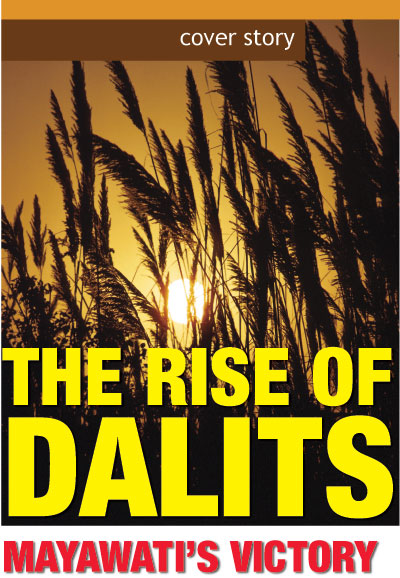 The rise of Bahujan Samaj Party and Mayawati to power in Uttar Pradesh is one of the most significant developments in Indian politics. There has been a corresponding rise in political consciousness of Dalits which has made a serious dent in the oppressive vertical system of exploitation based on caste hierarchy. This has, of course, been preceded by a similar assertion of backward caste politics in the post Mandal phase. Until 20 years back in Hardoi district an upper caste man could give a call to all chamars of a village to come to work on his field and it would have been very difficult for any of the chamars to defy the order. Similarly, the newly married bride in a fisherfolk community of Ballia district, until the previous generation, would have to spend the first night at the upper caste zamindar’s house because the entire community was living on a land provided by the zamindar. Once when this community had voted for a political party out of their own choice the zamindar had passed an edict banning them from using his land for the purposes of excretion. The community had to apologize and promise to vote according to zamindar’s wish in future elections. Such has been the tyranny of the caste system. These inhuman practices are slowly becoming history as Mayawati creates history of her own. The rise of Bahujan Samaj Party and Mayawati to power in Uttar Pradesh is one of the most significant developments in Indian politics. There has been a corresponding rise in political consciousness of Dalits which has made a serious dent in the oppressive vertical system of exploitation based on caste hierarchy. This has, of course, been preceded by a similar assertion of backward caste politics in the post Mandal phase. Until 20 years back in Hardoi district an upper caste man could give a call to all chamars of a village to come to work on his field and it would have been very difficult for any of the chamars to defy the order. Similarly, the newly married bride in a fisherfolk community of Ballia district, until the previous generation, would have to spend the first night at the upper caste zamindar’s house because the entire community was living on a land provided by the zamindar. Once when this community had voted for a political party out of their own choice the zamindar had passed an edict banning them from using his land for the purposes of excretion. The community had to apologize and promise to vote according to zamindar’s wish in future elections. Such has been the tyranny of the caste system. These inhuman practices are slowly becoming history as Mayawati creates history of her own.
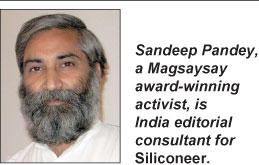 What Mayawati, representing the most vulnerable segment of the society, has been able to achieve is unthinkable even in American democracy or any other country of the world for a long time to come. She has wrested power from the powerful in a patriarchal feudal system entrenched in a casteist framework supported by mafia and criminals. The Congress party was trying its best to woo back its Dalit vote bank. It instead lost the Brahmins and Muslims as well to behenji, as Mayawati is known to her admirers. Mayawati is on top of an alliance which once formed the bedrock of the Congress party, the only truly genuine national party in the country. The only difference is that whereas the upper caste dominated leadership of Congress was controlling the Dalits, this time it is a Dalit controlling the rest. The Congress party remains a sorry bystander in this upturning of hierarchy. However progressive the Congress might be, it would have never tolerated an independent thinking Dalit leader. What Mayawati, representing the most vulnerable segment of the society, has been able to achieve is unthinkable even in American democracy or any other country of the world for a long time to come. She has wrested power from the powerful in a patriarchal feudal system entrenched in a casteist framework supported by mafia and criminals. The Congress party was trying its best to woo back its Dalit vote bank. It instead lost the Brahmins and Muslims as well to behenji, as Mayawati is known to her admirers. Mayawati is on top of an alliance which once formed the bedrock of the Congress party, the only truly genuine national party in the country. The only difference is that whereas the upper caste dominated leadership of Congress was controlling the Dalits, this time it is a Dalit controlling the rest. The Congress party remains a sorry bystander in this upturning of hierarchy. However progressive the Congress might be, it would have never tolerated an independent thinking Dalit leader.
With Mayawati’s coming to power everyone assumes that the law and order situation would improve and atrocities against Dalits would mitigate. She has already announced the long overdue increase in minimum wages of unskilled workers from Rs. 58 to Rs. 80 per day for eight hours of work. It is a definitely more progressive step than former Chief Minister Mulayam Singh Yadav’s dole of Rs. 500 as unemployment allowance per month to the educated youth. Whereas successive pay commissions have typically increased the salaries of service classes, nobody has paid attention to a proportionate increase in daily wages for unskilled laborers. The daily wages continue to be abysmally low compared to the incomes of other segments of society across the country.
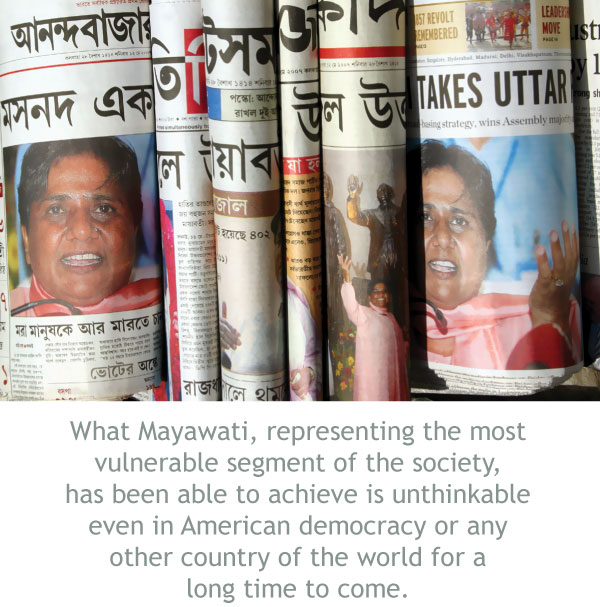
However, Mayawati is known to be an idiosyncratic and erratic politician. Her autocratic ways allow little space for democracy within the party. Her methods of distributing election tickets to the largest bidder do not create the sense of loyalty for the party or its ideology which is needed in the time of crisis. Professionals who see politics as an instrument of making money can be easily lured away by a more attractive offer, as Mulayam Singh proved during the last term of U.P. assembly.
Having acquired political equality the Dalits are now hoping to climb the social and economic ladder as well. In fact, most of the benefits meant for poor Dalits in the form of various government schemes through the panchayats or through schemes like the Public Distribution System or National Rural Employment Guarantee Scheme do not reach them, forcing them to live in situations of extreme poverty and deprivation. BSP must concentrate on these issues if it seriously intends to carry out upliftment of the Dalits. Mayawati must move out of the obsession to indulge in the symbolism politics of Ambedkar Parks to more concrete things which will impact the lives of ordinary Dalits in the state. There is no question that politics of symbolism has played an important role in the Dalit assertion. The statues of Dr. B.R. Ambedkar in every village have given a sense of identity and self-respect to the Dalits. This silent movement for the assertion of Dalit rights stands in importance next to the freedom struggle and the JP movement in recent history. There has been a feeling of liberation just like in the other two struggles. But having accomplished the political victory the Dalit movement has to now chart a course for the social and economic wellbeing of the Dalits. Reservations in educational institutions and jobs can help only a small fraction of Dalits. We need a blueprint for the development of the ordinary Dalit who is too poor to compete. This is the challenge of the future.
The combination with upper caste, especially Brahmins, which is being hailed as potent, has serious pitfalls. The political class which has always cornered all benefits flowing from the system is working overtime to subvert the BSP agenda. There is a danger of the take over of BSP by the contractor-mafia raj working through suave upper caste politicians and bureaucrats. Unless Mayawati and the Dalit leadership within the party is extremely careful of this attempt of subversion and can be guided by their absolute commitment to the cause of Dalits, BSP is in danger of being reduced to a party indistinguishable from any other opportunist political party.
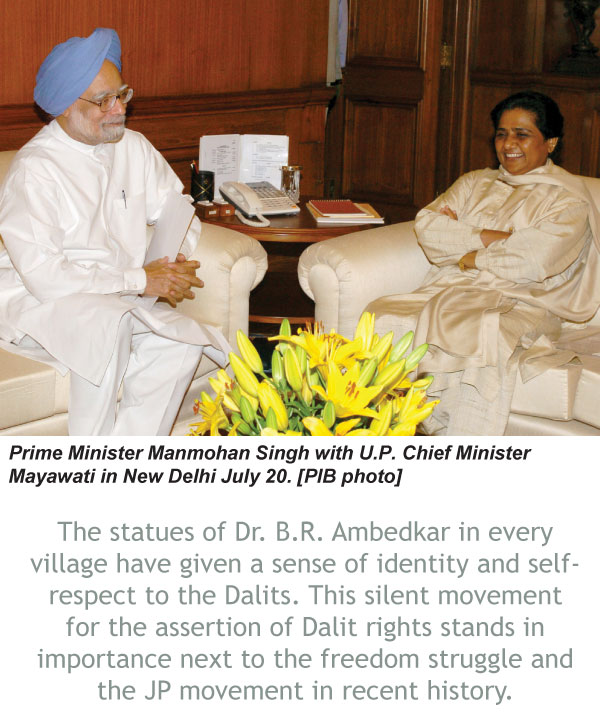
In her past stints as chief minister, Mayawati has given little attention to the well being of Dalits. Dalits found it as tough to get cases registered under the SC/ST (Prevention of Atrocities) Act and the state SC/ST Commission provided no relief either. Matters related to violence against women also suffered neglect in her regime. Neither did the situation of landless Dalits, hoping to take possession of their legitimate plots of land allotted to them by the panchayats, improve. All the other benefits through the panchayats continued to be siphoned off by the unscrupulous elements. There was no crackdown on corruption in the various schemes which could have possibly resulted in more benefits flowing to the Dalits. With the possible exception of Ambedkar villages, there was no overall improvement in delivery efficiency of the administrative system or justice to the poor.
The hope is that a more mature Mayawati, having survived the Taj Corridor folly, will bring better governance and development on her agenda and go down in history as more than a politician who indulged in politics of symbolism.
|TOP|
IMMIGRATION:
Three Cheers for Gandhigiri: A Floral Protest and the USCIS
Does Gandhigiri actually work? Skeptics may raise an eyebrow, but soon after 200 immigrants sent flowers to the U.S. Citizenship and Immigration Services to protest its abrupt rejection of applications, the USCIS changed heart. A Siliconeer report.

(Above, left): About 200 skilled immigrants sent flowers to the U.S. Citizenship and Immigration Services.
(Above, right): The flowers sent to USCIS were transferred to U.S. soldiers recovering at the Walter Reed Army Medical Center. [All photos by XIYUN YANG/THE WASHINGTON POST]
The magic of Gandhigiri has apparently worked for Indian Green Card seekers with the U.S. immigration department July 18 announcing that it will accept applications from foreign professionals seeking permanent residency through an expedited process, reversing its earlier decision.
The campaign that directed around a thousand flower deliveries to U.S. Citizenship and Immigration Services director Emilio Gonzalez was modeled on a popular Indian film promoting the peaceful protest methods of Mahatma Gandhi.
Inspired by the Bollywood movie Lage Raho Munnabhai, angry immigrant applicants had started a campaign to flood the Citizenship and Immigration Services headquarters with flowers after an abrupt withdrawal of a measure that promised expedited processing of their request for Green Card.
Thousands of holders of H1-B visas — reserved for skilled workers in computing and other special professions — scrambled and spent money on lawyers and medical exams to prepare green card applications as priority dates became current after a backlog of almost five years.
On July 2, 2007, USCIS announced that it would not accept any additional employment-based applications for this fiscal year.
The abrupt closure of this path to a green card — proof of lawful permanent resident status — sent the applicants back to the queue for 2008, when they will have to spend more time and money, organizers of the protest said.
“The gist of the campaign was to peacefully convey disappointment and concern at how things have evolved in the last month,” said Sivakanth Mundru, a Virginia-based computer systems analyst who was affected by the policy.
Gonzales said in a statement on the USCIS Web site that the agency would forward the flowers to Walter Reed Army Medical Center and Bethesda Naval Hospital in Washington, D.C., the main facilities treating U.S. soldiers wounded in Iraq and Afghanistan.
“We welcome the fact that the director at least acknowledged this campaign and we are happy that our flowers will be bringing some color to our soldiers in those two medical hospitals,” said Vikas Bajaj, a software developer in Wisconsin who helped organize the flower protest.
“The public reaction to the July 2 announcement made it clear that the federal government’s management of this process needs further review,” USCIS director Emilio Gonzalez said.
The USCIS said it would immediately start accepting employment-based applications to adjust status (Form I-485) filed by aliens whose priority dates are current under the July Visa Bulletin, No. 107. USCIS will accept applications filed not later than August 17, 2007.
|TOP|
NEWS DIARY: July 2007 Roundup
 Pratibha Patil Becomes India’s First Female President | Nepali Goddess Likes Instant Noodles | Strange Justice | Goodbye, Shambo | Legal Nightmare | Questions about Nuke Deal | Former Bangla PM Charged | Lanka Rally Pratibha Patil Becomes India’s First Female President | Nepali Goddess Likes Instant Noodles | Strange Justice | Goodbye, Shambo | Legal Nightmare | Questions about Nuke Deal | Former Bangla PM Charged | Lanka Rally
Pratibha Patil Becomes India’s First Female President
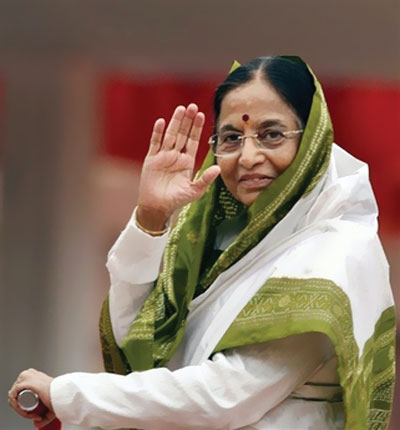 Pratibha Patil Pratibha Patil
India’s first female president was sworn in on July 26, after a vitriolic campaign which undermined the symbolism of the appointment and raised doubts about Pratibha Patil’s suitability for the ceremonial role, Reuters news agency reports.
The 72-year-old Patil, dressed in a white and green saree draped over her head, took the oath of office inside parliament’s packed and ornate central hall, promising to uphold the constitution and devote herself to the people of India.
“Today India stands at the threshold of a new era of progress,” she said. “We must make sure that every section of society, particularly the weak and disadvantaged, are equal partners and beneficiaries in the development process.”
But her words may count for little given her lack of power and the manner of her accession to the job.
The governor of Rajasthan, she had been plucked from relative obscurity to become the government’s compromise candidate for the job, after the coalition failed to agree on a host of other, male candidates.
Congress leader Sonia Gandhi, the most powerful politician in the country, then billed the appointment as a historic day for India’s women.
Critics said it was a hollow gesture after a campaign marred by bitter partisan politics and unprecedented mud-slinging.
“Don’t mock our intelligence and call it a victory for women. It is a selfish victory for the Congress party and its leadership,” columnist Suhel Seth wrote in the Asian Age newspaper.
|Back to NEWS Diary| |TOP|
Nepali Goddess Likes Instant Noodles
 Sajani Shakya Sajani Shakya
As goddesses go, this 10-year-old Nepali girl has modest ambitions. Some religious authorities threatened to strip Sajani of her “goddess” title after she promoted a film on her life, the Reuters news agency reports.
“I want to become a photographer,” said the shy Sajani Shakya as she jumped from the couch and grabbed an envelope with photographs of her recent visit to the United States.
Sajani hit world headlines this month as some religious authorities threatened to strip her of her “living goddess” title after she visited the United States to promote a British-made film about her life.
Nepali priests had enthroned Sajani as the Kumari or “living goddess” of Bhaktapur eight years ago — a position worshipped by thousands of Hindus and Buddhists alike in a deeply religious nation.
Sajani enjoys the more everyday pleasures of many kids — toys, dolls, and instant noodles for food.
The bright-eyed Sajani visited the Capitol in Washington, met with Nepalis living in the United States, toured a school and met American children.
Under the living goddess tradition followed for centuries in the three ancient cities in the Kathmandu valley, young girls are selected by priests to serve as incarnations of Kali, the Hindu goddess of power.
They remain in their “divine” role until menstruation when they must retire and rejoin the family. A new girl is then chosen.
|Back to NEWS Diary| |TOP|
Strange Justice
 Australian demonstrators protest the arrest of Mohamed Haneef. Australian demonstrators protest the arrest of Mohamed Haneef.
Indian-born doctor Mohamed Haneef was moved to a safe house after the case against him dissolved into fiasco, with Australia’s chief prosecutor admitting it had been bungled and there was no reasonable prospect of a conviction.
Dr Haneef was spirited out of prison hours after the charge against him was dropped and a clearly embarrassed Immigration Minister Kevin Andrews said he was seeking legal advice about whether the latest development meant he should reverse his decision to cancel the doctor’s visa.
The Commonwealth Director of Public Prosecutions, Damien Bugg, could not explain how a prosecutor falsely told a court that Dr Haneef’s SIM card was found in a burnt Jeep Cherokee at Glasgow Airport.
Australian Federal Police Commissioner Mick Keelty said police had done their job professionally and refused to apologize.
Andrews said Dr Haneef could leave prison and live in “residential detention” at his apartment on the Gold Coast or another place of his choosing.
Andrews said he would seek advice from the Commonwealth Solicitor-General on whether the decision to drop the charge against Dr Haneef had any bearing on his earlier decision to revoke his 457 work visa and deport him.
As immigration lawyers expressed fury about the way Dr Haneef’s case had been handled and minor-party politicians demanded that Andrews resign, the Labor Opposition, which until recently had supported the Commonwealth’s stance, called for an independent inquiry into the affair.
Queensland Premier Peter Beattie said Dr Haneef was welcome to return to his job at the Gold Coast Hospital if the Federal Government restored his work visa.
|Back to NEWS Diary| |TOP|
Goodbye, Shambo
 Shambo the sacred bull Shambo the sacred bull
The battle to save Shambo the sacred bullock ended July 26 after police overcame chanting protestors protecting the Friesian at a Hindu monastic community in Wales.
Dozens of praying campaigners had built a shrine for Shambo at the monastery and vowed to save him.
But after a 12-hour stand-off with Welsh Assembly officials, the six-year-old bullock, which has tested positive for bovine tuberculosis, was finally led away to slaughter after police intervened.
“At least everybody that has campaigned for Shambo’s survival can go to bed with a clear conscience, having tried everything they could,” said a spokesman for the Skanda Vale temple near Carmarthen.
The standoff at the Community of the Many Names of God had followed months of legal wrangling over the fate of Shambo.
An Appeal Court ruled this month that the bullock must die in accordance with government policy of slaughtering TB-positive cattle.
An Indian charity had agreed to take Shambo out of the country and more than 23,500 people signed a protest petition.
Cows are sacred to Hindus and the monastery spokesman said it would be “an appalling desecration of life” if the bullock were killed.
The National Farmers Union says no animal should be exempt from the rules governing TB and that to spare Shambo would be unfair on farmers who have had to see their stock slaughtered.
A spokesman for the Welsh regional government said the option of allowing Shambo to go to India was not possible because it would put other animals and people at risk.
|Back to NEWS Diary| |TOP|
Legal Nightmare
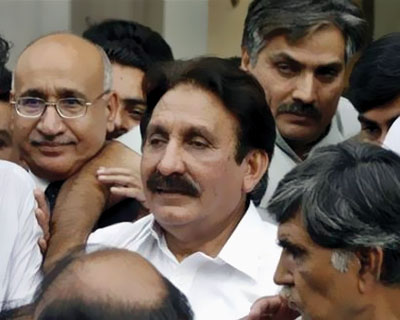 Iftikhar Chaudhry Iftikhar Chaudhry
The Supreme Court of Pakistan’s ruling that the country’s military ruler was wrong to sack the court’s top judge is, many Pakistani legal experts say, a “landmark judgement.”
Chief Justice Iftikhar Chaudhry was suspended by President Pervez Musharraf in March, facing charges of misconduct and abuse of powers.
The case was dealt with by his fellow judges. Now they have restored the chief justice with full powers.
The government’s response has been one of passive acquiescence. Prime Minister Shaukat Aziz said the government would abide by the court’s verdict.
The more than 1,000 lawyers who attended the court were ecstatic following the announcement of the verdict. They chanted the now traditional cry of “Go Musharraf go,” but this time more in euphoria than anger.
Legal experts are of the opinion that the judgement marks a watershed in Pakistan’s legal history and will have far-reaching implications for the rule of law in the country.
“The country has been reborn today,” said an emotionally charged Ali Ahmad Kurd, one of the lawyers who represented the chief justice. “Until today it was a body without a soul.”
The message for the government of Musharraf is not even remotely comforting.
“The court has completely demolished the government’s case and has put an uncomfortable question mark on its moral standing,” says Wasim Ahmad Shah, a legal affairs correspondent who works for Dawn newspaper.
“In coming days, the government will find it increasingly difficult to deny that it tried to get rid of a constitutional office holder with malafide intentions.”
|Back to NEWS Diary| |TOP|
Questions about Nuke Deal
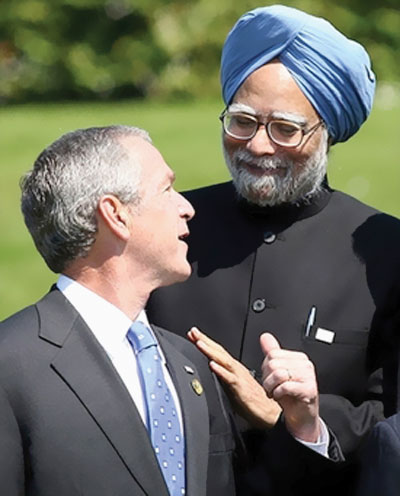 George W. Bush (l) with Manmohan Singh George W. Bush (l) with Manmohan Singh
U.S. lawmakers have warned President George W. Bush of “inconsistencies” amid reports Washington has agreed in principle to allow India to reprocess spent nuclear fuel under a landmark deal.
The warning came after U.S. and Indian officials finalized the implementing agreement for Washington to provide nuclear technology and fuel to India under a deal agreed upon by Bush and Indian Prime Minister Manmohan Singh two years ago to highlight ties between the world’s two biggest democracies.
Details of the so-called “123 agreement” has been kept under wraps but unconfirmed reports say the United States has agreed in principle to New Delhi’s proposal to reprocess spent fuel in a dedicated national facility under the International Atomic Energy Agency safeguards.
But Washington reportedly is reluctant to provide such reprocessing technology to India, which has been under three decades of US sanctions for nuclear tests. Nor is India a member of the nuclear Non-Proliferation Treaty.
The letter from 23 members of the House of Representatives warned: “Any inconsistencies between the so-called 123 agreement and U.S. laws would put final Congressional approval of the deal in doubt.
“If the 123 agreement has been intentionally negotiated to side-step or bypass the law and the will of Congress, final approval for this deal will be jeopardized,” said Edward Markey, co-chairman of the House Bipartisan Task Force on Nonproliferation.
|Back to NEWS Diary| |TOP|
Former Bangla PM Charged
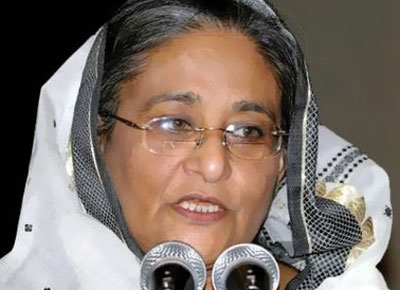 Sheikh Hasina Sheikh Hasina
Bangladesh authorities formally charged former Prime Minister Sheikh Hasina Wajed and two relatives with extorting $435,000 from a businessman as part of a corruption crackdown, an official said.
Sheikh Hasina, leader of the Awami League party, was accused with her sister and cousin in a charge sheet submitted to the court, said deputy police commissioner Shahidul Haque Bhuiyan.
“Sheikh Hasina has been charged by the investigating police and a date will now be fixed for the trial,” Bhuiyan added.
The Awami League chief was arrested last week in an early morning raid on her Dhaka residence.
According to the allegations, a company named East Coast Trading Ltd was given permission to set up a power plant in 2000 while Sheikh Hasina was prime minister, the private UNB agency said.
Associates of the then prime minister, however, allegedly pressed the firm for money and threatened to cancel the project if it refused to pay, UNB said.
Sheikh Hasina is one of 150 high-profile figures who have been arrested as part of an anti-corruption crackdown by Bangladesh’s military-backed emergency government, which took power in January following months of political violence.
|Back to NEWS Diary| |TOP|
Lanka Rally
Thousands of opposition supporters rallied against Sri Lanka’s President Mahinda Rajapaksa and demanded snap elections in the capital Colombo.
Protesters chanted “We want a UNP (opposition United National Party) government” and “Save the country from the Rajapaksa brothers.” The president’s three brothers are also in his administration.
Police said there were 15,000 protesters. The UNP were expecting 100,000.
“We are starting our mass agitation campaign to call for an election,” said UNP leader Ranil Wickremesinghe, who narrowly lost the presidency to Rajapaksa in November 2005 when Tamil Tiger rebels boycotted the poll and blocked residents in areas they control from voting.
Rajapaksa’s government is now embroiled in a new chapter of the island’s two-decade civil war with the rebels. An estimated 4,500 people have been killed since last year.
Wickremesinghe’s own party split earlier this year when 17 members, including his deputy, crossed over to the government, helping to give Rajapaksa a long-elusive parliamentary majority.
Protesters said they were fed up with high inflation, which hit 17 percent in June as measured on a 12-month moving average.
“It’s really difficult, people can’t bear the cost of living,” said 38-year-old businessman Ranjith Udumulla, who traveled to attend the protest from the gem-mining town of Ratnapura 65 km southeast of Colombo.
|Back to NEWS Diary| |TOP|
|